Got Choices?

The Language of Money
To start out, let us introduce two important concepts: the Balance Sheet and the Income Statement, sometimes also called the Profit and Loss statement, or P&L for short. Even if you are not an accountant, you have probably heard these terms from time to time. And depending on how much you have been involved in business or accounting, you may have some idea of what they each mean. But if you are like most people, you may only know they are both financial reports and you may not have a clear understanding of what they are for, why they are two separate reports and what is different or unique about each one.
The Balance Sheet
We will start by explaining the balance sheet. And to illustrate, assume we are talking about your balance sheet. This means, it will tell us something about what you own, or how wealthy you are.
Every time we do accounting, we have a set of data that represent a person or a group, such as a business or a family. Often, we call this set of data “your books.” This dates back to a time when a person’s transactions were written in bound books. Today, accounting records are more typically stored digitally on a computer.
So when we talk about your books, you are the entity the books are about. And we can organize the data in your books into something called a balance sheet.
Think of the balance sheet as a list of all the things you possess at any given time. For example, your balance sheet was probably a little different at the end of last year than it is today. If you are gradually accumulating more possessions, it will show a bigger total as time goes forward.
Each time we generate the report, it represents just a single instant in time. So you can have a balance sheet for today or yesterday, or the end of last year. But you don’t typically think of a balance sheet as representing things that have occurred throughout a span of time, such as during a month or year.
As we know, integer numbers come in two styles: positive and negative. Similarly, money and other possessions can be represented in both a positive and negative way. We call these assets and liabilities.
Those words are pretty intuitive to most of us. Assets sound like good things–things we value and want to keep. Liabilities sound like they are not so great and maybe something we want to get rid of. So assets are the things you own that are worth something positive. Examples include cash, food, jewelry, cars, houses and the like.
As it turns out, assets can also include less tangible things such as the promises of others.
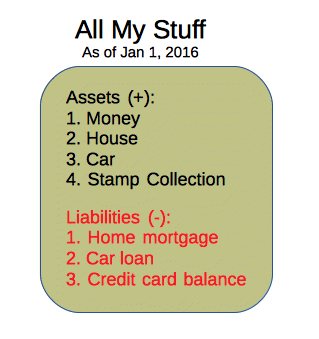 For example, if you trade something to someone, and they can’t pay you right away, they might give you an IOU, or a promise to you something later on.
For example, if you trade something to someone, and they can’t pay you right away, they might give you an IOU, or a promise to you something later on.
Such a promise is itself an asset. It is something of value you own and can make use of at a future time.
This notion of a promise will be key as we attempt to understand money better. But it also gives us some insight into the other half of our balance sheet, liabilities. A liability is something you possess that has negative value. For example, if you are the one who made the promise, or issued the IOU to someone else, then you possess a part of that promise as well, but for you, it has a negative value. That promise makes the total value of your possessions less, or more negative.
Assets can be either tangible or intangible. Tangible just means a commodity you can touch or hold such as a car, a house, or an article of clothing. A promise is intangible. You can write it down on paper, but the promise itself is not a commodity. It just represents a commodity you hope to obtain at some time in the future.
It is unusual for commodities to have a negative value. So most often if you have liabilities on your balance sheet, these represent promises to give something of value to someone else.
The totality of your possessions, both positive and negative, we call your “net worth.” The word net is in there because to get the total, we have to subtract the liabilities from the assets. This is how you determine what you are really worth, after your debts have been satisfied.
If you have more assets than liabilities, you are said to be “in the black or “solvent”. If you have more liabilities than assets, then you are “in the red” or “bankrupt.”
The balance sheet shows a snapshot of your total financial health at any given point in time. Specify a single date, and you can see a list of all accumulated assets and liabilities, culminating in your total and net worth at that moment.
The Income Statement
In contrast, an income statement is not a snapshot at all.
Rather, it relates to a period of time such as a year, a month, or a quarter.
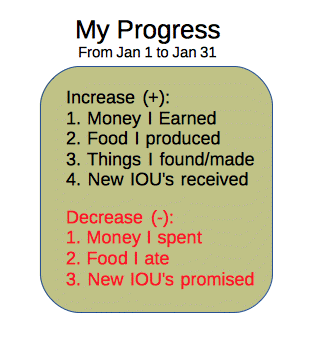 We typically have to specify two dates before we can generate an income statement: a beginning date and an ending date.
The report then explains how your net worth changed during that period of time.
We typically have to specify two dates before we can generate an income statement: a beginning date and an ending date.
The report then explains how your net worth changed during that period of time.
Did your net worth become more positive or more negative during the period? Did you become wealthier or did you lose some of what you had before?
Another way of looking at it is, the income statement shows how you interacted with other people or companies. That can happen in two ways: Maybe someone on the outside gave you something or you found, developed or created something new you hadn’t had before. This results in your possessions increasing.
Or, perhaps you gave something to someone or you consumed some of the things you had before. This results in your possessions getting smaller. We call these notions “income” and “expenses.” By including both on the income statement, we can see what happened during the specified time period to make you more or less wealthy.
As you would expect, income affects your balance sheet positively and expenses affect it negatively. The difference between the two amounts, we call “net income,” meaning the income, minus the expenses. So as you might imagine, your net worth on the balance sheet will grow or shrink by exactly the amount of net income shown on the income statement over the same period of time.
Methods of Accounting
Another thing to understand about accounting, whether on balance sheets or on income statements, is the numbers are always expressed in a single standard unit of money. For example, if you want to show cash on your balance sheet, that is easy–just put down the number of dollars in your bank account. But what if you want to show your house or your car on the same balance sheet? Those too are assets just as is cash. But a house isn’t money, it is a commodity. So how do we write it down as a number?
This might have different answers based on what kind of accounting you are using, but the basic answer is: we must pick a way of measuring value and then use that same unit of measure on all the various assets. For the house and car, we might enter the amount of money originally paid for those assets. This is called “cost accounting.” Then we might also have a way of showing how these assets lose a little bit of value each year as they gradually get old and wear out. The point is, we typically need to represent all assets and liabilities using the same measure of value across all our financial reports.
Each time we exchange value, either with another person, a company, or even within our own balance sheet, it is called a transaction. As a basic example, imagine you buy a drink at the store. For you, this would be an expense. Your balance sheet will get slightly smaller in the process. For the merchant, it is income. So his balance sheet will increase.
You can also perform transactions within your own set of possessions that don’t affect the outside world at all. For example, you might use some cash to pay off one of those liability promises that has been sitting on your balance sheet for several months. In this case, your assets (cash) get smaller or more negative. But at the same instant, your liabilities are also reduced, or made more positive so the result is neutral to you. Your net worth doesn’t change at all.
This notion can seem confusing at first. After all, when you pay off a promise, the money is going out to another person, right? That is correct. But the real expense happened when you made the promise in the first place.
Imagine in June, you buy a can of gas for $20 from your neighbor, but you don’t have the cash to pay him right away. He may well accept your promise to pay later, but still give you the gas right away so you can get your lawn mowed.
In that case, you incurred an expense and he received his income in June. His assets got more positive in the promises category by $20 in June. And your liabilities got more negative in the promises category by $20 in June. That is when the real change happened and will be recorded on your June income statements.
Later on, say in September, when you finally come up the cash, the only transactions will be internal to your two balance sheets. Your cash will decrease, but so will your debts. His cash will increase but his promises for future cash will decrease. Neither of you get richer or poorer in September.
This is the basis of accrual accounting. Changes, or activity that shows up on the income statement is recorded when commitments are made–not necessarily when cash changes hands. In reality, some entities use accrual accounting and others do not. For our purposes, it is helpful to understand this accrual method and how it works.
Accounts
As different transactions occur, they are tracked in individual compartments or cells we call accounts. For example, on the balance sheet, you would have some asset accounts and some liability accounts. Furthermore, you might have a separate account for each different kind of asset.
For example, the cash in your wallet might have its own account. There would be a separate account for the money you access at a bank when you write a check. And the cash you keep in savings at the same bank would also have its own separate account.
Where you own promises from other people, you might have a separate account for each different person who owes you something. An account just provides a total of all transactions, positive or negative that have affected that particular category. On the balance sheet, we compute the total of all past transactions. On the income statement, we only consider transactions between specified start and end dates.
Debits and Credits
Now let us talk about some accounting jargon that confuses a lot of people: debits and credits. Don’t be scared–they are just pluses and minuses. But maybe not in the way you think.
If you are not an accountant, chances are your total experience with debits and credits has come from your relationship with your bank.
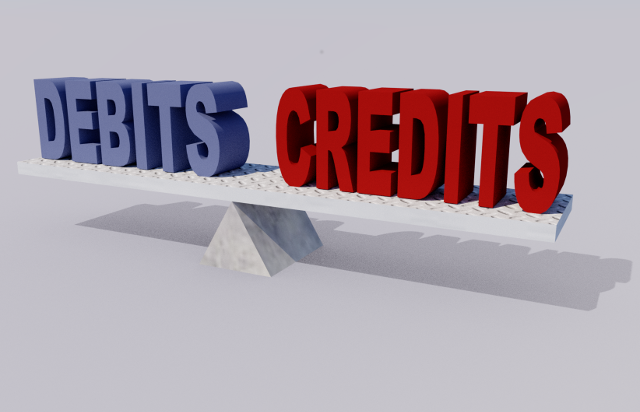 If so, you know a debit is a bad, or negative thing and a credit is a good, or positive thing–but you have it exactly backwards!
If so, you know a debit is a bad, or negative thing and a credit is a good, or positive thing–but you have it exactly backwards!
In the real language of accounting, a debit is positive and a credit is negative. Sometimes this drives people crazy when getting started in accounting. Is there an evil conspiracy among the banks to misinform us all? Perhaps, but not on this issue.
It is this simple: when the bank is talking about debits and credits, they are talking about your account on their books–not your books. When dealing with that account, what is an asset for you is a liability for the bank. What is income to you is an expense to them. This is why everything seems backwards.
When the bank debits your account, it means things are getting more positive, or better from their perspective. And that is bad, or negative for you. When they credit your account, things are getting more negative on their end, but that is good for you.
So that’s it. When you are working on your own books, debits are positive and credits are negative. Now you’re over it. Just memorize this important fact, accept it, and go on. Don’t let it frustrate you.
Balancing
Now let’s see how transactions work between accounts using debits and credits.
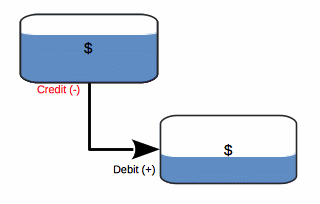 This figure shows two accounts pictured as containers and an arrow moving between them.
The containers hold value just as you might fill a tank with water or air.
This figure shows two accounts pictured as containers and an arrow moving between them.
The containers hold value just as you might fill a tank with water or air.
We might measure that value in dollars or pesos just as you might measure water in units of quarts or liters. It doesn’t matter what the measurement unit is–that doesn’t change how much water is in the container.
The arrow represents a transaction, or a flow of value. Imagine connecting a small tube between the two containers and squeezing the one on top so a little water runs through the tube into the one on the bottom. A transaction always has two ends, one giving and one receiving. No water is lost.
As the water moves, it will make things smaller, or more negative on the tail end of the arrow. And by the exact same amount, it will make things larger, or more positive on the head end of the arrow. It always has two parts, a credit and a debit and they are always equal and opposite so the net effect is zero.
Accountants call this being “balanced” and it is this basis for what is called “dual entry accounting.” The idea is to record each transaction in two different places independently, the credit side and the debit side. Then, later when you add up all the transactions, they should be equal to zero. If they are not, you know you have made a mistake somewhere and hopefully you can go back and find it.
Putting it Together
Now we are ready to put the pieces all together into a neat little graph so you can visualize things as we talk about them. There are 5 different basic account types. You have already learned 4 of them without really trying:
- Asset
- Liability
- Income
- Expense
The 5th one is called Equity and we’ll explain that one a little later.
Here you can see yourself, the “you” entity as the box in the center.
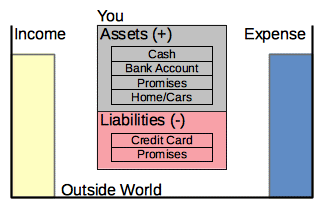 This represents your wealth, divided into two parts: assets and liabilities.
Within each area, you may have any number of accounts to track different kinds of things like cash, food, cars and promises.
This represents your wealth, divided into two parts: assets and liabilities.
Within each area, you may have any number of accounts to track different kinds of things like cash, food, cars and promises.
But we have also added some other boxes to represent everyone else in the world. We need these because, as we said, every transaction has two ends, a debit and a credit. But when you deal with the outside world, some of those arrows come from, or go to other people or businesses. So we will include them on our model, but they are not you–they are something outside of you.
The box on the left is used for income transactions and the box on the right is used for expense transactions. They really are part of the same box because they both represent everyone else. But we have stretched it out into a left and right side just so the arrows can always be shown moving from left to right. That is not too important–it just helps us separate things into the two different account types of income and expenses.
Finally, there is our 5th account type, Equity.
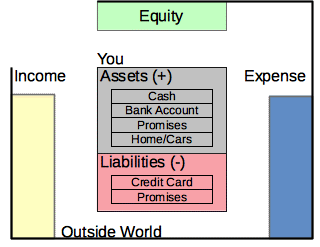 This represents your owner.
Hopefully, you are not a slave so you don’t have an owner, other than yourself.
But accounting is often used to represent a business.
And in that case, it does have one or more owners and those owners would have their own separate books and balance sheets.
So in our model, we will also show this as part of the “outside world.”
This represents your owner.
Hopefully, you are not a slave so you don’t have an owner, other than yourself.
But accounting is often used to represent a business.
And in that case, it does have one or more owners and those owners would have their own separate books and balance sheets.
So in our model, we will also show this as part of the “outside world.”
If you are just talking about your own books, rather than a business you own, you won’t use the equity section much. But that’s all right. One simple way to understand it is, equity represents the “other half” of the transactions resulting in the net worth we discussed as showing up on your balance sheet. And its total should always be exactly equal to your net worth, or assets minus liabilities.
A more formal explanation is, there are two kinds of claims against an entity’s assets: Debt and Equity. The debts are the top priority and represent those the entity owes money to. Once all the debts have been paid off, the remaining value is what the owners have left over for themselves.
When printing out a balance sheet, the equity section is nearly always shown after the assets and liabilities. Often there is a line showing the sum of liabilities and equity so you can make sure it is in balance with the assets.
Now think back to that can of gas we talked about previously.
In June when you bought it, we can draw an arrow going from your liability promises, over to your your neighbor Bob.
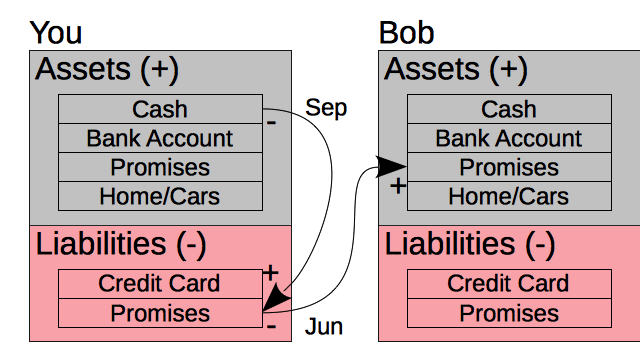 The arrow goes from left to right to show a credit, making things more negative for you, and a debit on the arrow head, making things more positive for Bob.
Later on, in September when you actually give Bob the money, we will add a second arrow moving from your cash, where the credit makes your cash more negative, down to your liabilities where it makes your promise to Bob more positive with a debit.
The arrow goes from left to right to show a credit, making things more negative for you, and a debit on the arrow head, making things more positive for Bob.
Later on, in September when you actually give Bob the money, we will add a second arrow moving from your cash, where the credit makes your cash more negative, down to your liabilities where it makes your promise to Bob more positive with a debit.
Since the debit to the promise is a positive $20 which is equal and opposite of the $20 credit we put in back in June, this completely extinguishes your promise to Bob. The account becomes zero, and you no longer owe anything to Bob. It turns out this notion of extinguishing debt will be important later on as we talk about how money is created and destroyed.
Now just to complete the picture, let’s assume you had some extra gas left over, so you used it in September to also mow the lawn of your other neighbor, Carol.
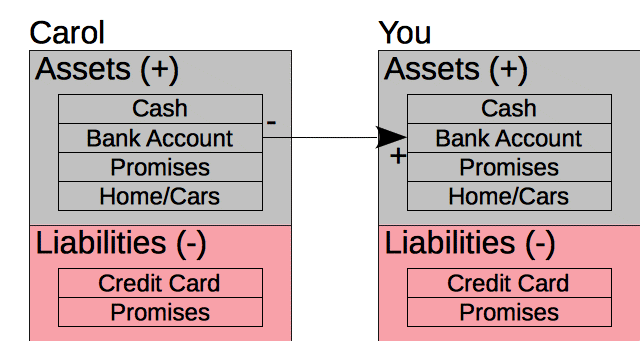 Carol was so grateful, she gave you $30 for your trouble.
But she didn’t have any cash at the time, so she gave you a check.
If you deposited that check into your checking account, we could draw the arrow on the left side going from Carol over to your checking account in your asset section.
The credit for Carol made her net worth a little more negative and the debit end made your net worth a little more positive.
Carol was so grateful, she gave you $30 for your trouble.
But she didn’t have any cash at the time, so she gave you a check.
If you deposited that check into your checking account, we could draw the arrow on the left side going from Carol over to your checking account in your asset section.
The credit for Carol made her net worth a little more negative and the debit end made your net worth a little more positive.
Normally, we don’t model other people’s balance sheets–just our own.
So on your own books, you wouldn’t show a credit coming from Carol’s checking account.
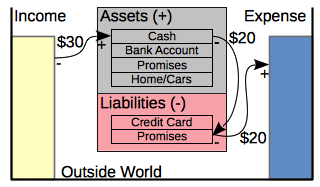 Instead, you would just credit an Income account such as Miscellaneous Jobs, for example.
Likewise, you would show the debit end of the transaction with Bob as an Expense account like Household Supplies.
Instead, you would just credit an Income account such as Miscellaneous Jobs, for example.
Likewise, you would show the debit end of the transaction with Bob as an Expense account like Household Supplies.
If you’ve been paying attention, something might be bothering you. Things on the income box are getting more negative because of credits and things on the expense side are getting more positive because of debits. That seems backwards since income seems like a positive kind of thing and expenses seem like a negative kind of thing.
Don’t panic. Just remember, in dual entry accounting, we are trying to keep track of both ends of every transaction. The Income and Expense boxes are not meant to model what is happening to you–they represent what is happening to other people you are dealing with. The opposite ends of the arrows are what affect you, or your balance sheet. So you can expect the signs to be backwards on income and expenses.
Finally, we get to how the income statement is generated. For a given time period, just consider all the transactions that have entered as income or exited as expenses. Then, reverse the signs so we can see the effect those transactions had on you, as opposed to the outside world. The difference between the income and expense will tell us the net, or total effect it had on you and your balance sheet.
If we were just showing your income statement for the two example transactions we discussed, it would show income of $30, and expenses of $20, for a net income, or profit of $10 in your brand new landscaping business! As you might expect, if we had printed out a balance sheet in May, and then another one in October, the later one would be larger by exactly the $10 of net income you earned. So as we intended, the income statement has shown the changes to the balance sheet for a specified period of time.
For our purposes, we don’t really need to deal much with Equity transactions. Maybe it is enough to point out, if we were modeling a business instead of an individual, the owners might be making initial contributions to the business in order to get it started. In this case, arrows would be shown moving from equity to the business’ assets, such as cash or equipment.
Later on when the business was successful, it might be in a position to make distributions back to its owners. Different from wages or dividends, distributions are simply a way of moving extra cash back out to the rightful owners of the business and are neither an expense to the business, nor necessarily income to the owners. Rather it is just a way for owners to move their assets around within their own individual balance sheet from one asset to another. So these distributions would be modeled by arrows moving from the company’s cash assets back out to the Equity box.
That is your basic accounting lesson. Hopefully, it wasn’t too painful. At least now you are better equipped to make sense of that next balance sheet you come across. More importantly, you are in a better position to make choices about how you want to use commodities, debt and money. And hopefully, it will be much easier to understand what money really is and how it works in our economy.
